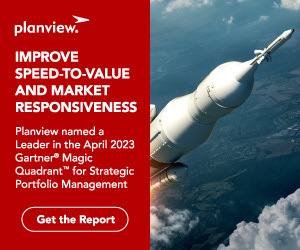
Best-in-class companies align their efforts so everyone is moving in the same direction – a direction towards the desired business outcomes.
They ensure that their goals and initiatives are aligned with their high-level strategy, from top leadership all the way down to the teams that deliver the work.
The C-suite has a holistic view across the lifecycle of its strategies, while the EPMO has delivery information at their fingertips to pivot funding when needed. Project leaders are solidly connected to what they are delivering and the outcomes their work is tied to.
Want to implement successful strategies in your own business that empower your enterprise for years to come? See why having a complete picture of your organization is the first step towards accelerating value delivery.
Make Better Decisions, Achieve Better Outcomes
Too often, organizations work in silos, causing necessary information to get stuck between teams and business functions. Teams don’t realize when they’re off-pace and leaders don’t recognize when they need to pivot.
Avoid this scenario by setting up a complete picture of your enterprise. Do it by combining portfolio management and Agile planning with value stream management.
Have real-time delivery and process insights continuously fed into portfolios, value streams, and teams so you can make decisions using real-time data from across the organization.
This will allow your enterprise to confidently make strategic decisions around funding work and managing capacity.
What’s the result of having a holistic view throughout your organization? Work will align with its strategic goals, setting your enterprise up for success as teams work to achieve those goals.
You’ll gain a greater understanding of your outputs, with predictive insights highlighting potential problems so you’re better equipped to address those problems – or avoid them completely.
To get these results, you must fill in the gaps between your strategy and delivery. Strategic and portfolio-level OKRs should be tied to team objectives. You’ll need to connect your short and long-term planning with both your high-level strategy and the execution and delivery of your work.
That means using value stream management feedback to alter plans, processes, and capacity to yield more value and efficiency.
While that seems like a daunting task, let’s take a look at what happens when organizations neglect to build a holistic picture of their business.
The Consequences of Disconnection
Too many enterprises lose sight of the importance of organizational transparency and collaboration. But there are serious costs to doing so.
For starters, disconnection leads to strategic drift. This is the frequent drift from strategic goals, resulting in funded initiatives that aren’t directly helping achieve your high-level objectives.
Disconnection also leads to work delays and inconsistent delivery. It makes keeping outcomes, delivery, and plans on track significantly harder. In other words, disconnection is a barrier inhibiting your organization’s ability to drive value.
Some of the biggest causes of disconnection that enterprises must address are:
- Inaccurate or outdated data: It’s harder to measure your return on investment and to assess potential risks when you don’t have an accurate representation of your company’s performance
- Working in silos: When departments and teams work in silos, they tend to focus on their own goals and objectives rather than how their work fits into the company’s strategy
Now that we’ve covered disconnection, let’s discuss the benefits of holistic visibility.
Realize Your Strategy with Holistic Visibility and Connected Work
Organizational transparency leads to:
- Leaders who are equipped to make fast, informed decisions around resources and funding – decisions aligned with the overall strategy and the financial impact of their choices
- Teams who make better decisions when it comes to work because of their understanding of the bigger picture and how their work fits into the company’s overall goals and objectives
Put simply, an organization that is aligned and connected delivers better results – and they deliver those results faster.
Having a single location where everyone in the business can view your OKRs will keep everyone focused on the most important deliverables when planning, prioritizing, executing, and delivering work.
In order to build that view, you’ll need to implement certain key tools and ways of working, including:
- Agile planning
- Portfolio management
- A high-performing work delivery platform
- Value stream management
- Strategic OKRs
Understanding each of these key elements is the start for better decision-making. With a clear view of each of these areas, you will achieve better outcomes for your organization.
But you also need to look beyond the data and make sure teams across the organization are on board.
Breaking down silos requires you to facilitate a unifying culture and understanding across your enterprise. A culture where everyone understands how their work contributes to the bigger picture – the company strategy.
When everyone understands how they contribute to achieving those organizational goals, planning, prioritization, and reprioritizing becomes easier.
Become an Organization That Consistently Executes and Delivers on Strategy
So, we know that modern organizations can’t afford to work in disconnected and inefficient ways. Lack of clarity and collaboration across a company leads to a misalignment with strategic goals, unpredictable work planning, poor performance, and more.
To combat this, leaders must promote organizational transparency and a holistic view of the entire company.
How can you put these learnings in place and ensure your organization keeps its plans, outcomes, and delivery on track?
Watch our on-demand webinar to see how Planview can provide you with a holistic view of your enterprise that lets you confidently plan, execute, and deliver on strategy.




